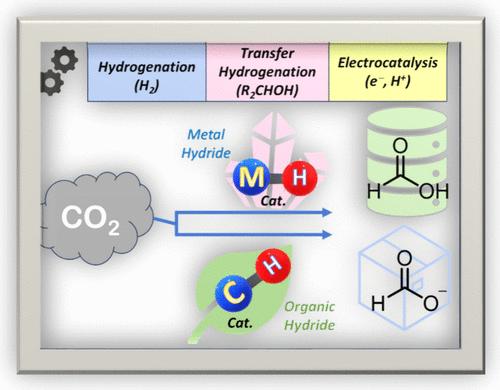当前位置:
X-MOL 学术
›
Acc. Chem. Res.
›
论文详情
Our official English website, www.x-mol.net, welcomes your
feedback! (Note: you will need to create a separate account there.)
Hydride Transfer-Based CO2 Reduction Catalysis: Navigating Metal Hydride to Organic Hydride in the Catalytic Loop
Accounts of Chemical Research ( IF 16.4 ) Pub Date : 2024-09-18 , DOI: 10.1021/acs.accounts.4c00442 Joyanta Choudhury 1 , Ritu Bhardwaj 1 , Sanajit Kumar Mandal 1
Accounts of Chemical Research ( IF 16.4 ) Pub Date : 2024-09-18 , DOI: 10.1021/acs.accounts.4c00442 Joyanta Choudhury 1 , Ritu Bhardwaj 1 , Sanajit Kumar Mandal 1
Affiliation

|
The reductive conversion of carbon dioxide (CO2) into value-added products is a process of immense importance. In the context of rising CO2 concentration in the atmosphere and the detrimental effects it is having on the biosphere, use of alternative fuels which can offer a low-carbon or carbon-neutral pathway for storage and utilization of low-carbon energy by maintaining the net atmospheric CO2 concentration might be a prospective solution. Among the wide variety of reduced products that can be obtained from CO2, formic acid and formate salts are particularly important due to their ability to be used as an alternative fuel or a reversible hydrogen storage material. Utilization of molecular catalysts for CO2 conversion offers several advantages such as high selectivity, mechanistic clarity, versatility, and stability, making them attractive for thermochemical and electro/photochemical CO2 reduction processes. The presence of N-heterocyclic carbene (NHC) ligands in transition-metal-based molecular catalysts enhances the stability of the catalysts under harsh reaction conditions, such as high pressure, high temperature, and reductive environments, providing crucial benefits for sustained catalytic activity and longevity. Though the development of metal complex-based catalysts is essential to addressing the challenge of CO2 reduction, the possibility of using purely organic compounds as catalysts for this transformation is lucrative from the aspect of developing a truly sustainable protocol with photosynthesis being its biggest inspiration. We begin this Account by examining our systematic development of molecular metal complexes based on NHC ligands for the chemical upgradation of CO2 to formic acid/formate salt. In such cases, the ability of NHCs to act as strong σ-donor ligands for a greater hydride transfer propensity is discussed and analyzed. The reports range from catalytic ambient- and high-pressure CO2 hydrogenation to CO2 transfer–hydrogenation. Coupling of CO2 capture methodologies with CO2 conversion is also discussed. A case is made for the heterogenization of one of the highly efficient metal-NHC catalysts to develop a self-supported single-site catalyst for practical applications. Finally, our recent success of developing a novel organic catalyst system inspired from the natural NADP+/NADPH-based hydride-transfer redox couple that is active in photosynthetic CO2 reduction has been discussed. This catalyst is designed based on a bis-imidazolium-embedded heterohelicene with a central pyridine ring and is capable of electrocatalytically converting CO2 to HCO2H with TON values 100–1000 times greater than the existing reported values achieved so far by organic catalysts. Overall, we believe that the results of hydride transfer-based CO2 reduction catalysis presented in this Account hold significant implications beyond our work and have the potential for motivating future research toward further development in this important field.
中文翻译:

基于氢化物转移的 CO2 还原催化:在催化回路中将金属氢化物导航为有机氢化物
二氧化碳 (CO2) 的还原转化为增值产品是一个极其重要的过程。在大气中 CO2 浓度上升及其对生物圈产生的有害影响的背景下,使用替代燃料,通过保持大气中CO2 净浓度,为低碳能源的储存和利用提供低碳或碳中和途径可能是一个有前景的解决方案。在可从 CO2 获得的各种还原产品中,甲酸和甲酸盐尤为重要,因为它们能够用作替代燃料或可逆储氢材料。利用分子催化剂进行 CO2 转化具有多种优势,例如高选择性、机理透明度、多功能性和稳定性,使其对热化学和电/光化学 CO2 还原工艺具有吸引力。过渡金属基分子催化剂中存在 N-杂环卡宾 (NHC) 配体,增强了催化剂在高压、高温和还原环境等恶劣反应条件下的稳定性,为持续的催化活性和寿命提供了关键优势。尽管开发基于金属络合物的催化剂对于应对 CO2 还原的挑战至关重要,但从开发真正可持续的方案(光合作用是其最大的灵感)的角度来看,使用纯有机化合物作为这种转变的催化剂的可能性是有利可图的。 我们首先研究了基于 NHC 配体的分子金属络合物的系统开发,用于将 CO2 化学升级为甲酸/甲酸盐。在这种情况下,讨论和分析了 NHC 作为强 σ 供体配体以实现更大的氢化物转移倾向的能力。报告范围从催化常温和高压 CO2 加氢到 CO2 转移-加氢。还讨论了 CO2 捕获方法与 CO2 转化的耦合。本文为一种高效金属-NHC 催化剂的异质化提供了一个案例,以开发用于实际应用的自支撑单位催化剂。最后,我们最近成功开发了一种新型有机催化剂系统,该系统的灵感来自天然的基于 NADP+/NADPH 的氢化物转移氧化还原对,该对光合 CO2 还原具有活性。该催化剂基于双咪唑包埋的杂螺旋烯设计,具有中心吡啶环,能够电催化将 CO2 转化为 HCO2H,其 TON 值比有机催化剂迄今为止达到的现有报告值高 100-1000 倍。总体而言,我们相信,本报告中介绍的基于氢化物转移的 CO2 还原催化的结果具有超出我们工作范围的重大影响,并有可能激励未来研究在这一重要领域进一步发展。
更新日期:2024-09-18
中文翻译:

基于氢化物转移的 CO2 还原催化:在催化回路中将金属氢化物导航为有机氢化物
二氧化碳 (CO2) 的还原转化为增值产品是一个极其重要的过程。在大气中 CO2 浓度上升及其对生物圈产生的有害影响的背景下,使用替代燃料,通过保持大气中CO2 净浓度,为低碳能源的储存和利用提供低碳或碳中和途径可能是一个有前景的解决方案。在可从 CO2 获得的各种还原产品中,甲酸和甲酸盐尤为重要,因为它们能够用作替代燃料或可逆储氢材料。利用分子催化剂进行 CO2 转化具有多种优势,例如高选择性、机理透明度、多功能性和稳定性,使其对热化学和电/光化学 CO2 还原工艺具有吸引力。过渡金属基分子催化剂中存在 N-杂环卡宾 (NHC) 配体,增强了催化剂在高压、高温和还原环境等恶劣反应条件下的稳定性,为持续的催化活性和寿命提供了关键优势。尽管开发基于金属络合物的催化剂对于应对 CO2 还原的挑战至关重要,但从开发真正可持续的方案(光合作用是其最大的灵感)的角度来看,使用纯有机化合物作为这种转变的催化剂的可能性是有利可图的。 我们首先研究了基于 NHC 配体的分子金属络合物的系统开发,用于将 CO2 化学升级为甲酸/甲酸盐。在这种情况下,讨论和分析了 NHC 作为强 σ 供体配体以实现更大的氢化物转移倾向的能力。报告范围从催化常温和高压 CO2 加氢到 CO2 转移-加氢。还讨论了 CO2 捕获方法与 CO2 转化的耦合。本文为一种高效金属-NHC 催化剂的异质化提供了一个案例,以开发用于实际应用的自支撑单位催化剂。最后,我们最近成功开发了一种新型有机催化剂系统,该系统的灵感来自天然的基于 NADP+/NADPH 的氢化物转移氧化还原对,该对光合 CO2 还原具有活性。该催化剂基于双咪唑包埋的杂螺旋烯设计,具有中心吡啶环,能够电催化将 CO2 转化为 HCO2H,其 TON 值比有机催化剂迄今为止达到的现有报告值高 100-1000 倍。总体而言,我们相信,本报告中介绍的基于氢化物转移的 CO2 还原催化的结果具有超出我们工作范围的重大影响,并有可能激励未来研究在这一重要领域进一步发展。


















































 京公网安备 11010802027423号
京公网安备 11010802027423号